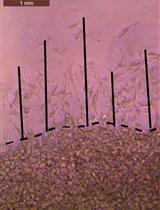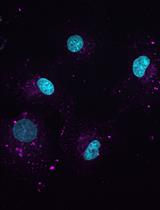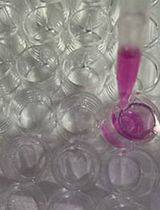- EN - English
- CN - 中文
Analysis of Random Migration of Cancer Cells in 3D
癌细胞随机迁移的3D分析
发布: 2020年01月05日第10卷第1期 DOI: 10.21769/BioProtoc.3482 浏览次数: 6184
评审: Pilar VillacampaGuillermo Gomezsujan kumar mondal
Abstract
The ability of cancer cells to migrate through a complex three-dimensional (3D) environment is a hallmark event of cancer metastasis. Therefore, an in vitro migration assay to evaluate cancer cell migration in a 3D setting is valuable to examine cancer progression. Here, we describe such a simple migration assay in a 3D collagen-fibronectin gel for observing cell morphology and comparing the migration abilities of cancer cells. We describe below how to prepare the collagen-fibronectin gel castings, how to set up time-lapse recording, how to draw single-cell trajectories from movies and extract key parameters that characterize cell motility, such as cell speed, directionality, mean square displacement, and directional persistence. In our set-up, cells are sandwiched in a single plane between two collagen-fibronectin gels. This trick facilitates the analysis of cell tracks, which are for the most part 2D, at least in the beginning, but in a 3D environment. This protocol has been previously published in Visweshwaran et al. (2018) and is described here in more detail.
Keywords: Collagen gel (胶原凝胶)Background
The migration of cells within our body is an essential process and driven by complex underlying cellular functions. It plays an important role in many physiological processes, including development, immune responses, and tissue regeneration (Kunwar et al., 2006; Friedl and Weigelin, 2008; Reig et al., 2014). In addition, certain pathological situations such as tumor invasion and metastasis rely on cell motility (Thiery, 2002). Consequently, cell migration has become a major field of study in the context of both fundamental and translational research. Although in the last decade we have witnessed enormous advances in the understanding of the mechanisms underlying the highly plastic process of cell migration, many questions remain open. Especially, the complex regulation of migration is still unclear within differently composed microenvironments that are crowded by cells and extracellular matrix (Petrie et al., 2009; Friedl and Wolf, 2010).
To analyze cell migration, several in vitro and in vivo cell migration assays have been developed over the years. Thein vivo cell migration assays most closely mimic the real physiological situation and observe cells within their natural environment with its complexities of variable extracellular matrix (ECM) composition, geometry, topography and pore size. However, performing such experiments is labor- and cost-intensive, time-consuming, tough to control and requires advanced imaging techniques and animal experiments. Due to such practical challenges, cell migration has traditionally been studied on two-dimensional (2D) surfaces (Dang and Gautreau, 2018), e.g., in the context of wound-healing assays (Molinie and Gautreau, 2018). While this works to some extent for adherent cells such as breast epithelial carcinoma cells, 2D migration assays have little physiological relevance and thus little predictive value. Moreover, the striking difference between the 2D and the 3D settings becomes understandable in the light of recent studies of cell motility (Lämmermann et al., 2009; Friedl et al., 2012; Petrie and Yamada, 2016). These recent studies demonstrate that cell migration is a very plastic process and the cells embedded in 3D matrices composed of collagens or matrigel employ a very different locomotory machinery than cells on 2D surfaces. Therefore, studying the migration of cells embedded within a physiological-like 3D environment could lead to the results that have more significance and better predictive value.
Apart from being easier to perform than true in vivo migration experiments, 3D migration assays with their simpler matrix composition offer the advantage of a controlled, easily manipulable environment. Thus, it facilitates easy dissection of molecular mechanisms and the interpretation of experimental results. The 3D migration studies are usually done with the help of Boyden chambers (e.g., transwell assays [Visweshwaran et al., 2018]). However, these assays typically provide only an endpoint readout of cell migration efficiency, thereby not much information derived for an in-depth analysis. In contrast, real-time microscopy-based 3D assays allow one to observe and track individual cells, and thus the analysis of various parameters such as cell morphology during migration, cell speed, and directionality.
To our knowledge, there are not many optimal methods available for 3D cell migration analysis. All existing methods have their limitations. They either allow the experimenter to use a set-up where the embedded cells in the collagen gel are prone to migrate randomly in all directions including Z-axis, which render them hard to track and quantify migration parameters, or compel the experimenter to use complex, hard-to-handle and often costly setups (Rommerswinkel et al., 2014; Biswenger et al., 2018) to perform 3D migration assays. To overcome these limitations, we have developed a set-up where cells are sandwiched in a single plane between two collagen-fibronectin gels. This procedure facilitates the analysis of cell tracks, which are for the most part 2D, at least in the beginning, but in a 3D environment. In essence, here we describe an easy method for performing and analyzing 3D migration assays based on a home-made set-up and an easy analysis pipeline.
Materials and Reagents
- µ-slide 8 well with a glass bottom (Ibidi, catalog number: 80827)
- Cell line: MDA-MB-231 (ATCC, catalog number: HTB-26)
- L-15 medium (Thermo Fisher Scientific, catalog number: 11415049)
- Fetal bovine serum (FBS) (Thermo Fisher Scientific, catalog number: A31605)
- Penicillin-Streptomycin (100x) (Thermo Fisher Scientific, catalog number: 15140122)
- Trypsin (0.25%) (Thermo Fisher Scientific, catalog number: 15050065)
- DPBS (Thermo Fisher Scientific, catalog number: 14190250)
- 10x MEM (Thermo Fisher Scientific, catalog number: 11430030)
- HEPES (Thermo Fisher Scientific, catalog number: 15630080)
- Collagen I (Rat-tail, 4.41 mg/ml) (BD Biosciences, catalog number: 354236)
- Fibronectin (5 mg) (FN) (Sigma, catalog number: F1141)
- MDA-MB-231 culture medium (see Recipes)
- Collagen-Fibronectin gel mix (see Recipes)
Equipment
- Phase contrast microscope with 20x air objective, temperature module, CO2 module and auto focus module (Zeiss Axio Observer microscope)
- 37 °C cell culture incubator
- Laminar airflow hood
Software
- Fiji: ImageJ with MTrackJ plugin
Note: Fiji: ImageJ, software could be downloaded from https://imagej.net/Fiji/Downloads and for MTrackJ plugin information go to https://imagescience.org/meijering/software/mtrackj/. - Microsoft (MS) Excel 2007 or later
Procedure
文章信息
版权信息
© 2020 The Authors; exclusive licensee Bio-protocol LLC.
如何引用
Visweshwaran, S. P. and Gautreau, A. (2020). Analysis of Random Migration of Cancer Cells in 3D. Bio-protocol 10(1): e3482. DOI: 10.21769/BioProtoc.3482.
分类
癌症生物学 > 侵袭和转移 > 细胞生物学试验 > 细胞迁移
癌症生物学 > 侵袭和转移 > 细胞生物学试验 > 细胞侵袭
细胞生物学 > 细胞运动 > 细胞迁移
您对这篇实验方法有问题吗?
在此处发布您的问题,我们将邀请本文作者来回答。同时,我们会将您的问题发布到Bio-protocol Exchange,以便寻求社区成员的帮助。
提问指南
+ 问题描述
写下详细的问题描述,包括所有有助于他人回答您问题的信息(例如实验过程、条件和相关图像等)。
Share
Bluesky
X
Copy link














